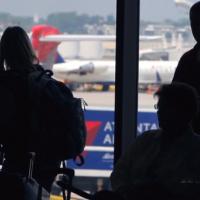[ad_1]
MONTREAL – Preliminary figures released by the International Civil Aviation Organization (ICAO) show a total of 4.3 billion passengers were carried by air transport on scheduled services in 2018. This indicates a 6.1 per cent increase over 2017. The number of departures rose to approximately 38 million globally, and world passenger traffic, expressed in terms of total scheduled revenue passenger-kilometres (RPKs), grew solidly at 6.7 per cent and reached approximately 8.2 trillion RPKs performed. This growth is a slowdown from the 7.9 per cent achieved in 2017.
Over half of the world’s 1.4 billion tourists who travelled across international borders last year were transported by air, and that air transport now carries some 35% of world trade by value. Indeed, around 90% of cross border Business-to-Consumer (B2C) e-commerce was carried by air transport.
The final official figures will be released in the 2019 Annual Report of the Council.
Air travel growth eased but remained solid supported by the global economic conditions
Air travel growth has eased in comparison to the strong upward trend seen in 2017. The stimulus of lower air fares to travel demand has reduced due to the higher fuel prices from the last two years, reflecting the moderation in growth momentum. However, air traffic growth remained solid in 2018, underpinned by the global economic conditions throughout the year. Despite recent softening, world real gross domestic product (GDP) growth is projected to be at 3.1 percent in 2018 before slowing gradually over the next two years, according to the World Bank estimates. Advanced-economy growth decelerates, and the recovery in major commodity-exporting emerging market and developing economies levels off. The financial market stress, escalating trade protectionism and heightened geopolitical tensions continue to cloud the outlook.
Passenger traffic
International scheduled passenger traffic expressed in terms of RPKs grew by 6.4 per cent in 2018, down from the strong 8.4 per cent recorded in 2017. All regions posted slower growth than last year, with the exception of an improvement in North America driven by the stronger US economy and continued international expansion of Canadian carriers. The region carried a 12 per cent share of world international RPKs and recorded a rebound from the 4.9 per cent in 2017 to 5.2 per cent in 2018. Asia/Pacific, the second largest international market with a 30 per cent RPK share, remained as the fastest growing region with an increase of 7.3 per cent, albeit a moderation from the robust growth of 10.5 per cent in 2017. Europe recorded the second highest growth at 6.7 per cent and was the largest international market with a 37 per cent share. This was followed by the 6.6 per cent and 6.5 per cent growth in Latin America/Caribbean and Africa, which accounted for the smallest RPK share of 4 per cent and 3 per cent, respectively. Carriers in the Middle East managed 14 per cent of world international RPKs, and became the slowest growing region with a growth of 4.7 per cent, impacted by a number of factors such as the competitive environment – competing hubs and more point to point services, low oil prices and geopolitical tensions.
In terms of domestic scheduled passenger services, overall markets grew by 7.3 per cent in 2018, slightly up from the 7.1 per cent in 2017. This upward trend was helped by the strengthening in the domestic air travel demand in North America which accounted for 40 per cent of the world domestic RPKs. The region demonstrated an increase in growth from 3.7 per cent in 2017 to 5.4 per cent in 2018. In addition, Asia/Pacific, the world’s largest domestic market with 42 per cent of traffic share, continued to grow double-digitally at 10.4 per cent, contributed by the strong demand in India and China, owing to their increasing GDP per capita and growing domestic air connectivity.
Low-cost carrier activity
The low-cost carriers (LCCs) consistently grew at a faster pace than the world average growth, and its market share continued to increase, both in advanced and emerging economies. In 2018, the LCCs carried an estimated 1.3 billion passengers, and accounted for approximately 31 per cent of the world total scheduled passengers. Market share of LCCs was the highest in Europe representing 36 per cent of total passengers carried in the region, followed by Latin America/Caribbean, North America, and Asia/Pacific with 35 per cent, 30 per cent and 29 per cent, respectively.
Load factors improved to a record high
Increase in air travel demand outstripped the industry capacity expansion. Total capacity offered by the world’s airlines in 2018, expressed in available seat-kilometres (ASKs), increased globally by around 6.0 per cent. As a result, overall passenger load factor improved by 0.6 percentage points and reached a record high of 81.9 per cent. Two regions, Latin America and the Caribbean and the Middle East, posted a decline in load factors, as being under pressure with the slowing trend in traffic growth. Load factor varies by region, ranging from 71.8 per cent for Africa to 84.5 per cent for Europe.
Airline financial results
Average jet fuel prices increased by approximately 31 per cent in 2018 compared to 2017 but remained notably lower than the prices observed for the ten years prior to 2015. The low fuel cost coupled with a solid increase in traffic helped the airlines to maintain a relatively high record of profitable level in 2018 albeit slightly lower from 2017. The airline industry is expected to end 2018 with another record operating profit of around USD 57 billion and an operating margin of 7.0 percent. The net profits for the Industry is expected to be around USD 34 billion with nearly half of this being generated by air carriers of North America.
Deceleration in global economic growth forecasted by the World Bank could see moderation in traffic growth and profitability momentum in 2019.
[ad_2]You can read more of the news on source
 Travelsmart
Travelsmart



